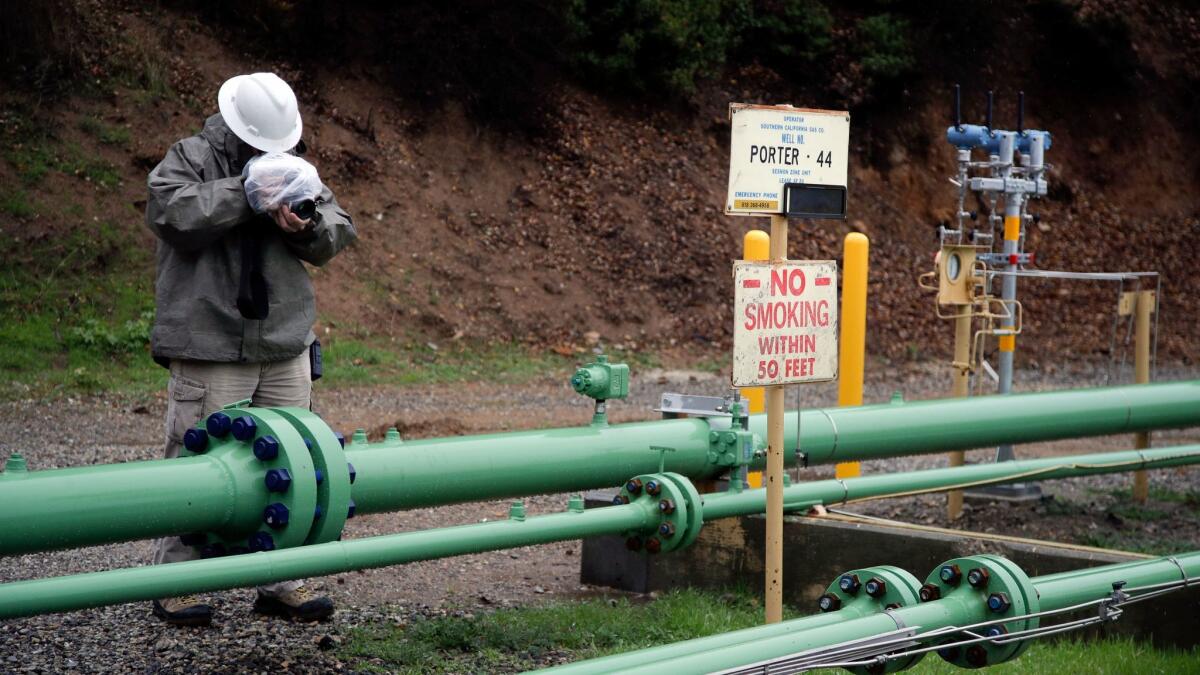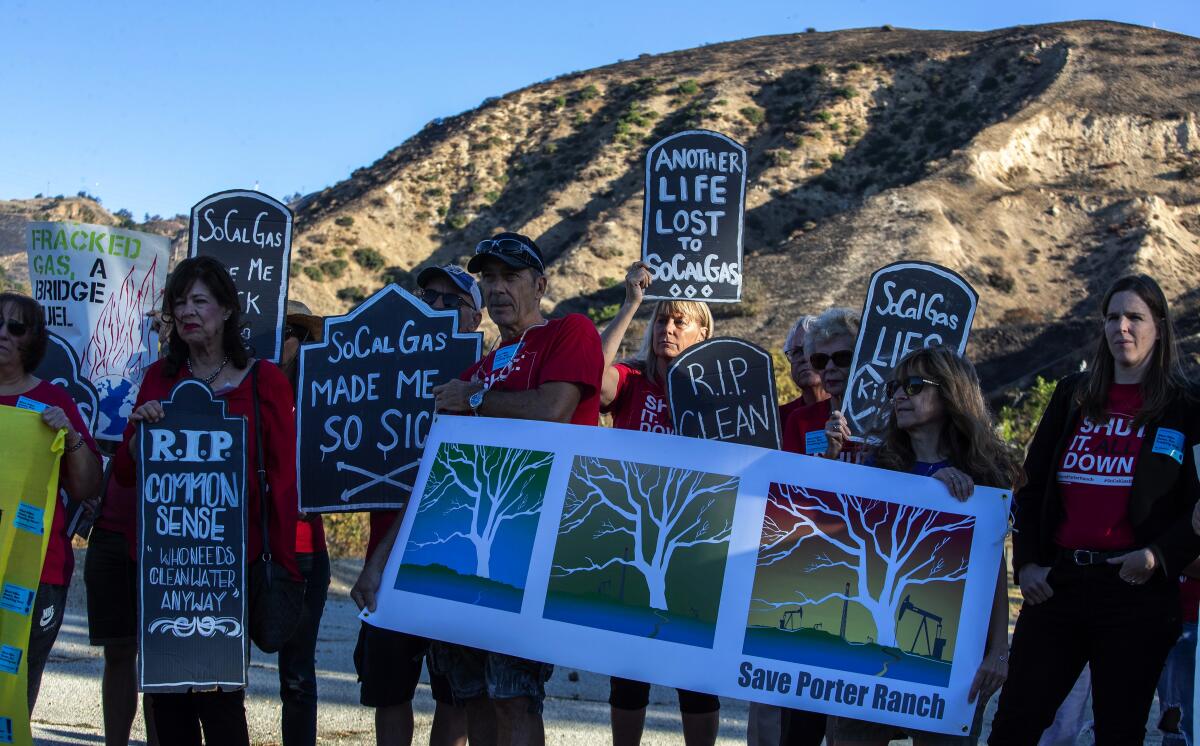Newsom explores faster shutdown of Aliso Canyon natural gas facility

- Share via
Four years after a massive leak at the Aliso Canyon natural gas storage facility forced thousands of families in the northwest San Fernando Valley to evacuate, Gov. Gavin Newsom has called on California’s utilities regulator to look into accelerating the facility’s permanent shutdown.
The California Public Utilities Commission should “immediately engage an independent third-party expert to identify viable alternatives to the facility and scenarios that can inform a shorter path to closure,” Newsom wrote in a Monday letter to commission President Marybel Batjer, whom he appointed four months ago.
The commission is “fully prepared” to comply with the governor’s request, a commission spokeswoman said. She did not estimate how long it would take.
Southern California Gas Co., the facility’s operator, has long said Aliso Canyon is essential to meet the region’s energy needs and has pushed for state officials to lift restrictions on its capacity.
“Natural gas stored at Aliso Canyon continues to help prevent service interruptions to large natural gas customers and power plants on high-demand days,” gas company spokesman Chris Gilbride said in an email. “Given the public’s growing concern for an affordable energy system that reliably works, it is curious to hear the governor talk about closing one of California’s largest energy storage assets.”
While on the campaign trail last year, Newsom said he was “fully committed” to shut down Aliso Canyon but could not act unilaterally.
The 2015 blowout at the facility led to the largest known release of methane gas in U.S. history. Residents of the area reported suffering from nausea, headaches, nosebleeds and other ailments. Some say they are still feeling health effects.
The governor is facing criticism from proponents of the shutdown who say he’s moving too slowly.

“We are concerned that another study without a timeline for closure kicks the can down the road and continues to leave the community at risk,” said Alexandra Nagy, state director of the environmental group Food & Water Action. “We urge Gov. Newsom to show leadership and clarify that he expects the facility to be permanently closed within a year.”
Proponents of shutting Aliso Canyon have pointed to a 2017 study conducted by an energy consulting group for Los Angeles County that said natural gas injections at the site were not needed in the short term. In the long term, the report said, improvements in areas such as energy efficiency and carbon-free storage will make Aliso Canyon obsolete.
Southern California Gas, a subsidiary of San Diego-based Sempra Energy, has countered by citing warnings from state agencies that Aliso Canyon is still needed to ensure energy reliability.
In May, the California Independent System Operator, which oversees the power grid for about 80% of the state, said the outlook in Southern California “remains challenging due to uncertainty about the status of its natural gas system” and pointed to the gas company’s pipeline outages and restrictions on Aliso Canyon.
The California Council on Science and Technology, a nonprofit established by the Legislature in 1988, said in a report last year that although the need to store gas underground might be reduced in the future, “we found no immediate measures that would overcome California’s demand of natural gas during peak periods in the winter — a demand that currently exceeds the state’s pipeline capacity to import gas.”
The debate over the future of Aliso Canyon comes as the state aims to derive all of its electricity from zero-carbon sources by 2045. Although natural gas burns cleaner than coal, it is still a fossil fuel.
And it accounts for the largest single source of in-state energy generation: 46.5%, according to the California Energy Commission.
Southern California Gas is engaged in a wide-ranging campaign to preserve the role of its pipelines in powering society.
The Public Utilities Commission is already trying to determine whether use of the Aliso Canyon facility can be reduced or eliminated. This month, the commission said it was worried about a potential shortfall in the state’s power system within two years, and it extended by a few years the life of four natural gas power plants in the Los Angeles area.
The Aliso Canyon methane leak was first detected in October 2015 and was not permanently contained until February 2016. State regulators estimated 4.62 billion cubic feet of natural gas escaped. One billion cubic feet is enough gas to supply about 5 million U.S. homes for one day. According to a UC Davis study, the total greenhouse gas pollution equaled the emissions of 500,000 cars driven for a year.
Natural gas injections resumed at Aliso Canyon in July 2017, with limitations. At first, storage capacity was restricted to about 28% of the facility’s maximum capacity. That number has since increased to about 39% of maximum capacity, or 34 billion cubic feet.
This year, the gas company estimated the cost of the leak at $1.07 billion. The company faces nearly 400 lawsuits from about 48,500 plaintiffs that are still outstanding.
More to Read
Inside the business of entertainment
The Wide Shot brings you news, analysis and insights on everything from streaming wars to production — and what it all means for the future.
You may occasionally receive promotional content from the Los Angeles Times.











